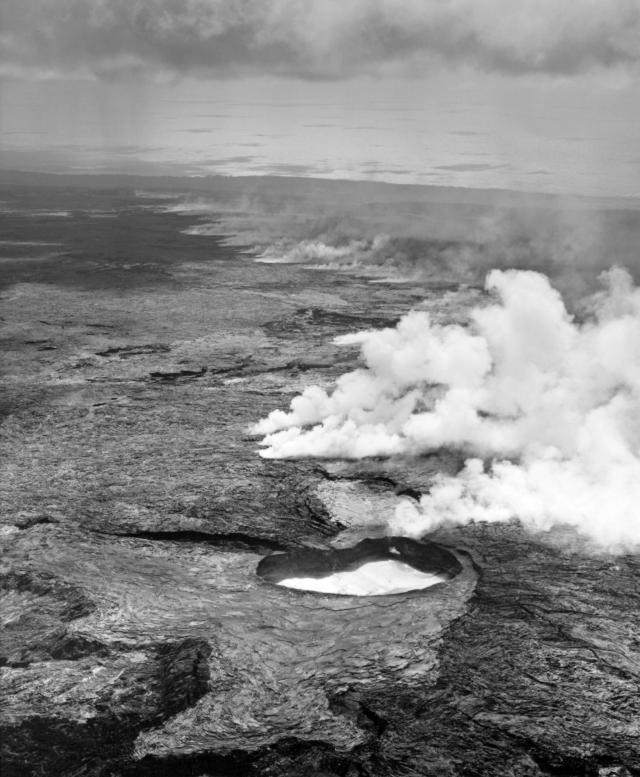Report on Kilauea (United States) — February 1988
Scientific Event Alert Network Bulletin, vol. 13, no. 2 (February 1988)
Managing Editor: Lindsay McClelland.
Kilauea (United States) Lava continues to enter ocean; littoral cones and tephra
Please cite this report as:
Global Volcanism Program, 1988. Report on Kilauea (United States) (McClelland, L., ed.). Scientific Event Alert Network Bulletin, 13:2. Smithsonian Institution. https://doi.org/10.5479/si.GVP.SEAN198802-332010
Kilauea
United States
19.421°N, 155.287°W; summit elev. 1222 m
All times are local (unless otherwise noted)
Lava . . . continued . . . building deltas near Kupapau Point and farther E near the old Damien church site (figure 53). The W lobe had several active fronts and more volume than the E lobe. Near the end of February, the volume of lava feeding the E lobe began to decrease slowly, and by 1 March growth of the eastern delta had ceased. During the same period, the W lobe began to increase in volume along all the fronts that were entering the ocean, causing explosions and forming small littoral cones. A small spatter rampart was formed by one flow. Sand-sized tephra was produced by some of the explosions, and flakes of basaltic glass > 5 cm long, formed by steam bubbles rising through lava and exploding at the water's surface, were found as far as 1-2 km downwind of the steam columns.
The flow that . . . destroyed three more houses on the 11th reached the bottom of the steep slope and stopped on 14 February. The lava pond . . . overflowed intermittently 31 January-2 February, raising the N rim of the lava shield 6-8 m. The lava level dropped to 5-10 m below the rim for the rest of the month, at times exposing the top 2-3 m of the outlet to the tube system (figure 54). Lava fountaining and gas piston activity . . . at Pu`u `O`o continued. Strombolian activity and fountaining deposited spatter and reticulite pumice on the rim.
Harmonic tremor continued at a low level . . . beneath Pu`u `O`o and the shield vent. The generally constant tremor amplitude was occasionally interrupted by many hours of gas piston activity, characterized by 1-minute tremor bursts repeating at intervals of ~3-15 minutes. In the summit region, the number of shallow microearthquakes peaked at nearly 400/day then gradually decreased to < 100/day by the end of February. However, there were intermittent swarms of long-period events and weak tremor at shallow and intermediate depths beneath the summit region. Of the thousands of recorded earthquakes during February, 16 of the strongest had magnitudes ranging from 2.5 to 4.6. The M 4.6 event, at 1847 on 19 February, was centered on the S flank of Kīlauea at 9 km depth. It was widely felt on the E half of the island, but no structural damage was reported.
Geological Summary. Kilauea overlaps the E flank of the massive Mauna Loa shield volcano in the island of Hawaii. Eruptions are prominent in Polynesian legends; written documentation since 1820 records frequent summit and flank lava flow eruptions interspersed with periods of long-term lava lake activity at Halemaumau crater in the summit caldera until 1924. The 3 x 5 km caldera was formed in several stages about 1,500 years ago and during the 18th century; eruptions have also originated from the lengthy East and Southwest rift zones, which extend to the ocean in both directions. About 90% of the surface of the basaltic shield volcano is formed of lava flows less than about 1,100 years old; 70% of the surface is younger than 600 years. The long-term eruption from the East rift zone between 1983 and 2018 produced lava flows covering more than 100 km2, destroyed hundreds of houses, and added new coastline.
Information Contacts: C. Heliker and R. Koyanagi, HVO.


